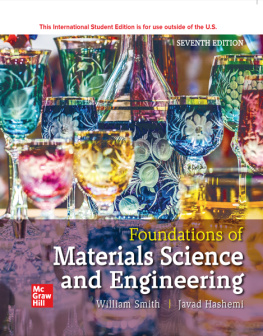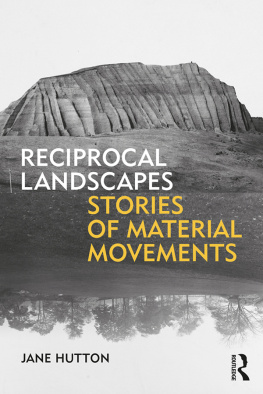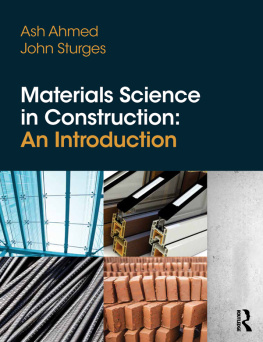PENGUIN BOOKS
THE NEW SCIENCE OF
STRONG MATERIALS
James Edward Gordon was born in 1913. He took a degree in naval architecture at Glasgow University and worked in wood and steel shipyards, intending to design sailing ships. On the outbreak of the Second World War he moved to the Royal Aircraft Establishment at Farnborough, where he worked on wooden aircraft, plastics and unorthodox materials of all kinds, designing the sailing rescue dinghies carried at one time by most bomber aircraft. He later became head of the plastic structures sections at Farnborough and developed a method of construction in reinforced plastics which is now used for a number of purposes in aircraft and rockets. For several frustrating years he worked in industry on the strength of glass and the growth of strong whisker crystals. In 1962 he returned to government service as superintendent of an experimental branch at Waltham Abbey concerned with research and development of entirely new structural materials, most of which were based on whiskers. He was Industrial Fellow Commoner at Churchill College, Cambridge, and became Professor of Materials Technology at the University of Reading, where he was later Professor Emeritus. He was awarded the British Silver Medal of the Royal Aeronautical Society for work on aircraft plastics and also the Griffith Medal of the Materials Science Club for contributions to material science. His book, Structures or Why Things Dont Fall Down, is also published in Penguin.
Professor Gordon died in 1998. In its obituary The Times wrote of him that he was one of the founders of materials science and that he wrote two books of outstanding literary quality at once entertaining and informative, providing absorbing interest for both expert and student.
J.E. Gordon
The New Science of Strong Materials
or Why you dont fall through the floor
SECOND EDITION

PENGUIN BOOKS
PENGUIN BOOKS
Published by the Penguin Group
Penguin Books Ltd, 80 Strand, London WC2R 0RL, England
Penguin Putnam Inc., 375 Hudson Street, New York, New York 10014, USA
Penguin Books Australia Ltd, 250 Camberwell Road, Camberwell, Victoria 3124, Australia
Penguin Books Canada Ltd, 10 Alcorn Avenue, Toronto, Ontario, Canada M4V 3B2
Penguin Books India (P) Ltd, 11 Community Centre, Panchsheel Park, New Delhi 110 017, India
Penguin Books (NZ) Ltd, Cnr Rosedale and Airborne Roads, Albany, Auckland, New Zealand
Penguin Books (South Africa) (Pty) Ltd, 24 Sturdee Avenue, Rosebank 2196, South Africa
Penguin Books Ltd, Registered Offices: 80 Strand, London WC2R 0RL, England
www.penguin.com
First published in Pelican Books 1968
Reprinted with minor revisions, 1971, 1973, 1974
Second edition 1976
Reprinted in Penguin Books 1991
First published in the United States by Walker & Co., New York, 1968
Copyright J. E. Gordon, 1968,1976
All rights reserved
Except in the United States of America, this book is sold subject to the condition that it shall not, by way of trade or otherwise, be lent, re-sold, hired out, or otherwise circulated without the publishers prior consent in any form of binding or cover other than that in which it is published and without a similar condition including this condition being imposed on the subsequent purchaser
ISBN: 978-0-14-192770-1
To my wife for putting up with it
The habit of apprehending a technology in its completeness: this is the essence of technological humanism, and this is what we should expect education in higher technology to achieve. I believe it could be achieved by making specialist studies the core around which are grouped liberal studies which are relevant to these specialist studies. But they must be relevant; the path to culture should be through a mans specialism, not by-passing it
A student who can weave his technology into the fabric of society can claim to have a liberal education; a student who cannot weave his technology into the fabric of society cannot claim even to be a good technologist.
Lord Ashby, Technology and the Academics
Contents
List of Plates
Wells Cathedral (By courtesy of A. F. Kersting)
Cantilever beam loaded at one end
S. S. Schenectady
Silica glass rod bent elastically to a strain of 7 per cent (By courtesy of Dr J. W. Morley and Messrs Rolls Royce Ltd)
Cracks caused by slight accidental contact on the surface of Pyrex glass (Proceedings of the Royal Society, A.249)
Deliberate scrape on a microscope cover-glass (Proceedings of the Royal Society, A.249)
Devitrification in silica glass (Proceedings of the Royal Society, A.249)
The cellular structure of wood greatly enlarged (Dr John Dinwoodie, Crown Copyright)
Tin whiskers growing spontaneously on a tin-plated surface (By courtesy of C. C. Evans)
Growth steps on large whisker crystal (By courtesy of C. C. Evans)
Effect of weak interfaces in stopping or hindering cracks (By courtesy of G. Cooper)
Whiskers or needle crystals of hydroquinone growing from solution in water
Fracture in thin polythene sheet (By courtesy of Professor Sir Charles Frank, F.R.S.)
The first direct photograph of an edge dislocation (By courtesy of Sir James Menter, F.R.S.)
Trevithicks 1805 high-pressure locomotive (Science Museum, London)
Hedleys eight-wheeled locomotive (Science Museum, London)
Acknowledgements
We are grateful to the Royal Society for permission to use the following figures: , is reproduced by courtesy of J. T. Norton and B. M. Loring (Welding Journal, Research Supplement, June 1941).
Foreword to First Edition
Anyone venturing to write a book covering nearly the whole field of strong materials must give many hostages to his colleagues for his mistakes, his oversimplifications, his omissions and for his pure ignorance. Such a book is necessarily highly selective and, in practice, the choice must be personal I hope that I may be forgiven for writing about what has interested me. There are people much better fitted than I to write, for instance, about alloy steels or titanium.
Although the book is published by permission of the Ministry of Technology, the views expressed, like the errors, are entirely my own.
Materials science and elasticity are generally pursued as rather mathematical subjects. However, I have cut out the whole of the mathematics except for a very little genuinely childish elementary algebra which can be followed by anybody with a negligible effort. In most cases I have substituted Roman titles for the Greek ones which are commonly used by the professionals (i.e. s for (stress), e for (strain) and so on). Simple transliteration returns these formulae to their common text-book form.
I should like to thank Dr W. D. Biggs of Christs College, Cambridge, for reading the book in proof and for making useful suggestions and Mr Gerald Leach for encouragement and patient literary criticism.
Foreword to Second Edition
I owe a considerable debt of gratitude to many of my colleagues at Reading University for their help in revising this book and bringing it up to date; especially to Professor W. D. Biggs, Dr Richard Chaplin and Dr Giorgio Jeronimidis. I have also taken into account comments and criticisms from correspondents in various parts of the world who have been kind enough to write to me.
With regard to units, it is impossible to please everybody. I have tried to achieve some kind of compromise or symbiosis between S.I. and traditional Anglo-Saxon which I hope that readers will not find too emotionally disturbing.
Next page







